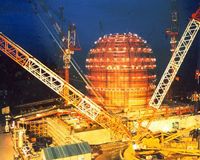 |
Tokyo (AFP) March 26, 2011 The giant TVs are silent, the neon lights dark and the bars of Tokyo half-empty. Two weeks after Japan's deadly earthquake, the city that once never slept is learning to live with a new era of frugality. Many public escalators are idle, the trains less frequent and the usually overflowing shelves of the round-the-clock convenience stores sparsely stocked. In the daytime, under the crisp winter skies, the city almost seems to have recovered from the shock of the massive March 11 earthquake which sent a huge tsunami crashing into northeast Japan and triggered a nuclear crisis. But nightfall reveals the reality -- a fortnight after the twin disaster struck, the capital is still a shadow of its former self. Nowhere is the contrast more evident than in the usually vibrant teen fashion district of Shibuya. The huge television screens and illuminated billboards that usually light up one of the world's busiest pedestrian intersections are lifeless -- victims of an energy crunch that is expected to drag on for weeks if not months. Even the normally ubiquitous store workers with loudhailers are absent. "It's almost too much. It doesn't seem like Shibuya anymore," said student Shiyo Suzuki, hanging out with his friends near the statue of Hachiko, a dog famed for his loyalty, a traditional meeting place by Shibuya station. The shops close earlier than usual, leaving apologetic signs that ask for the understanding of those clients who do arrive at their doors. "Before the earthquake, there were many customers between 7 and 8 pm, but now they go home earlier," said one saleswoman at a men's clothing shop. The taxi drivers, known for their white gloves and doors which swing open at the touch of a button, are also feeling the pinch. "We have no passengers. People don't go out or they go home early by train," one driver lamented. In normal times the capital's myriad bars and restaurants brim with office workers letting off steam after a long day in the office. But few are in the mood for socialising these days and food safety is a major concern since abnormally high levels of radiation from a tsunami-crippled nuclear plant were detected in food and even tap water. "I avoid going to restaurants because of the problems with food and vegetables found to contain radioactive substances," said one 38-year-old company worker. Nobody knows when life will return to normal for the 35 million residents of the greater Tokyo area, even if conditions are immeasurably better than those endured by survivors in the quake and tsunami zone further north. "The factories have halted, the roads in the northeast are hard to navigate, petrol there is rationed and power is sometimes cut. We're not getting the usual deliveries," said a worker at a FamilyMart convenience store in Tokyo. The 9.0-magnitude tremor and ensuing tsunami prompted 11 of Japan's 55 nuclear reactors to automatically shut down and also damaged several thermal power plants. The government has imposed rolling blackouts and asked people and businesses to save power as Tokyo Electric Power Co. struggles to meet demand. But the real crunch could come in the hot summer months of July and August when Japanese usually crank up the air conditioning. In the meantime frequent aftershocks have rattled the city -- which has long been braced for the "Big One" -- but there have been so many tremors recently that residents now seem to barely notice. And on top of the visible privations, residents must live with the knowledge that 250 kilometres (155 miles) to the northeast, radiation-suited workers are battling to bring a stricken nuclear plant back under control. Many foreigners have fled and embassies closed, fearful that dangerous levels of radiation might reach the capital, but for Japanese with jobs and families, leaving is not so easy. Instead, they yearn for a return to normality. "From now on everyone has to do all they can so that this doesn't drag on," said 18-year-old Nobuya Matsuda, one of those who -- despite the new era of sobriety and thrift -- refuses to abandon the streets of Shibuya.
Share This Article With Planet Earth
Related Links
 Japan faces prolonged energy crunch
Japan faces prolonged energy crunchOsaka (AFP) March 25, 2011 Disaster-struck Japan is bracing for months of energy shortages that could curb factory production and force households and workers to sweat out the humid summer with little or no air conditioning. The world's number three economy, which endures 20 percent of all major earthquakes, generates about 30 percent of its power from nuclear plants. The record 9.0-magnitude tremor and monster wa ... read more |
|
| The content herein, unless otherwise known to be public domain, are Copyright 1995-2010 - SpaceDaily. AFP and UPI Wire Stories are copyright Agence France-Presse and United Press International. ESA Portal Reports are copyright European Space Agency. All NASA sourced material is public domain. Additional copyrights may apply in whole or part to other bona fide parties. Advertising does not imply endorsement,agreement or approval of any opinions, statements or information provided by SpaceDaily on any Web page published or hosted by SpaceDaily. Privacy Statement |